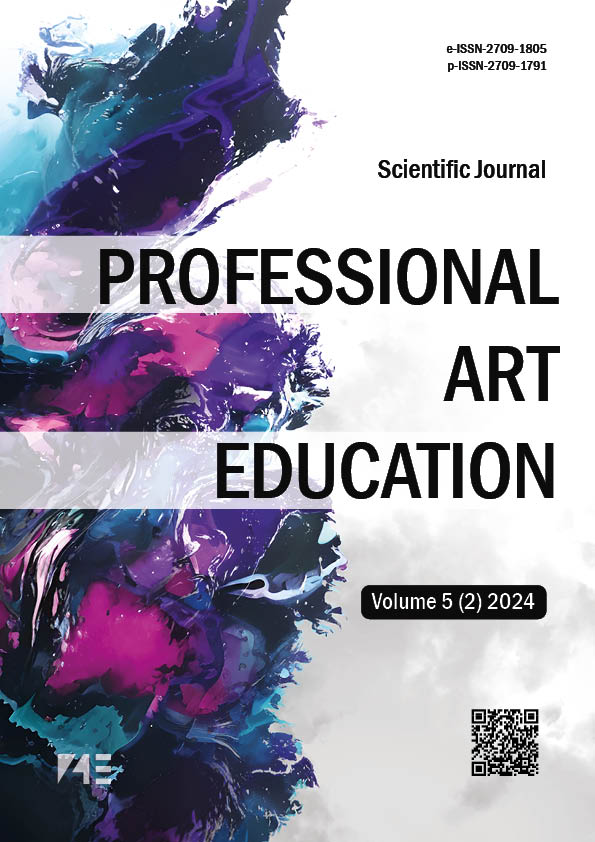Integration of music therapy and vocal pedagogy in the training of special education professionals in the PRC
DOI:
https://doi.org/10.34142/27091805.2024.5.02.13Keywords:
music therapy, vocal pedagogy, singing, speech correction, SOVT, special education, inclusive education, PRC, portfolio-based approach, interdisciplinarityAbstract
The article is devoted to the integration of music therapy and vocal pedagogy in the training of bachelor-level special education professionals in the PRC as an evidence-based, interdisciplinary model for forming readiness to use singing for speech correction in children with SEN. The logic of the curriculum is revealed (modules from basic vocal-speech skills to integrated mastery), the “bridges” between singing and speech (recitative, declamation, syllables/phonemes, rhythmized tongue-twisters), the ethical and vocal-hygiene framework (including SOVT techniques), as well as multidimensional assessment (perceptual, acoustic, behavioral indicators and the student’s portfolio). The institutional conditions for implementation in the PRC and the model’s transfer potential are emphasized.
Methods and methodology. The methodological basis is interdisciplinarity (speech therapy—music pedagogy—psychology/neurophysiology of voice) and a practice-oriented approach (learning by doing). Content and comparative analysis of educational practices were applied, along with the description of session protocols (SOVT exercises, breathing-resonance techniques, intonation-movement practices) and a portfolio-based assessment approach with validated indicators (clarity/expressiveness, MPT, pitch stability, initiation of phrases, tolerance for error).
Scientific novelty. A holistic structure for integrating music therapy and vocal pedagogy into the training of special education professionals is substantiated as a systemic educational project. The “bridges” between singing and speech are formalized as transfer mechanisms of the corrective effect.
Results. Reproducible session scenarios are summarized that confirm the effectiveness of the integrated model. The block aimed at speech breathing and phonatory stability is built as a sequence of SOVT warm-up (phonation through a straw, lip trills). The strand focused on diction and prosody combines articulatory-phonetic games (“mirror” for lips/tongue/jaw), legato/staccato on syllables, improvisational singing on rhythmic patterns, and the trajectory “reading—recitative—singing” with variation of tempo and dynamics; assessment is carried out using indicators of perceptual clarity, the number of spontaneous initiations, and tolerance for error. It is shown that the modular architecture ensures a consistent transition from basic skills to integrated mastery, while the portfolio approach increases transparency and instructional manageability of results. Institutionally in the PRC, the model is supported by a normative emphasis on aesthetic education, quality assurance mechanisms, and practices (micro-courses, inter-university casework, supervision), which strengthens scalability.
Conclusions. The integration of music therapy and vocal pedagogy in the training of special education professionals in the PRC forms a comprehensive professional readiness to use singing as an evidence-based means of speech correction. The combination of “bridges” between singing and speech, vocal-hygiene standards (SOVT, dosage), practice orientation, and multidimensional assessment ensures safe, stable, and reproducible learning and therapeutic outcomes, as well as a high potential for intercultural transfer of the model.
Downloads
References
Adriaansen, A., Cloete, E., & de Bodt, M. (2022). Effects of voice therapy in children with vocal fold nodules: A systematic review. International Journal of Language & Communication Disorders, 57(5), 1032–1046. https://doi.org/10.1111/1460-6984.12754
Angadi, V., Croake, D., & Stemple, J. (2019). Voice therapy and vocal function exercises: Evidence and application in pediatrics. Journal of Voice, 33(4), 572–579.
Bandura, A. (2012). Social cognitive theory. In P. A. M. Van Lange, A. W. Kruglanski, & E. T. Higgins (Eds.), Handbook of theories of social psychology (pp. 349–373). Sage Publications Ltd. https://doi.org/10.4135/9781446249215.n18
Chai, L. (2023). Music therapy and rehabilitation training for children with speech impairment. MEDS Public Health and Preventive Medicine, 3(1), 58–65. https://doi.org/10.23977/phpm.2023.030109
Christiner, M., & Reiterer, S. (2013). Song and speech: Examining the link and its implications for language learning. Frontiers in Psychology, 4, 803. https://doi.org/10.3389/fpsyg.2013.00803
Gardner, H. (1993). Multiple intelligences: The theory in practice. Basic Books.
Merrett, D. L., Peretz, I., & Wilson, S. J. (2013). Moderating variables of music training-induced neuroplasticity: a review and discussion. Frontiers in Psychology, Volume 4 https://doi.org/10.3389/fpsyg.2013.00606
Rinta, T. & Welch, G. (2008). Should Singing Activities Be Included in Speech and Voice Therapy for Prepubertal Children? Journal of Voice, Volume 22, Issue 1, 100–112 https://www.jvoice.org/article/S0892-1997(06)00101-9/abstract
Titze, I. R. (2006). Voice training and therapy with a semi-occluded vocal tract: Rationale and scientific underpinnings. Journal of Speech, Language, and Hearing Research, 49(2), 448–459. https://doi.org/10.1044/1092-4388(2006/035)
Сак, Т. В., Прохоренко, Л. І., Соколова, Г. Б., Дмітрієва, М. В., Бабяк, О. О., Баташева, Н. І., & Недозим, І. В. (2018). «Віконечко»: Програма розвитку дітей дошкільного віку із затримкою психічного розвитку від 3 до 7 років (за ред. Л. І. Прохоренко). Київ: Інститут спеціальної педагогіки НАПН України. URL: https://lib.iitta.gov.ua/id/eprint/712591/1/
Бондар, В. І., & Синьов, В. М. (ред.). (2021). Українська спеціальна педагогіка в персоналіях. Запоріжжя: Вид-во Хортицької національної академії. ISBN 978-966-8157-87-5. URL: https://lib.iitta.gov.ua/id/eprint/725008/1/
Інститут спеціальної педагогіки і психології імені М. Ярмаченка НАПН України (ред.). (2024). «Безбар’єрність в освіті осіб з особливими потребами: досвід та інновації»: Матеріали Х Міжнародного конгресу зі спеціальної педагогіки та психології (24–25 жовтня 2024 р.). Київ: ІСПП НАПН України. URL: https://lib.iitta.gov.ua/id/eprint/743070/1/Рібцун_конгрес_2024.pdf
Downloads
Published
License
Copyright (c) 2024 Чай Ліхуа (Автор)

This work is licensed under a Creative Commons Attribution-NonCommercial 4.0 International License.














